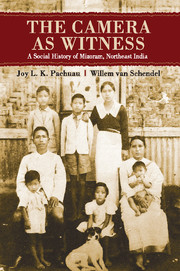Book contents
- Frontmatter
- Contents
- List of Figures
- List of Maps
- Acknowledgements
- I Becoming Mizo
- II Mizoram in the New India
- III Visions of Independence
- 17 Famine and Revolt
- 18 The Mizoram Government at Home and in East Pakistan
- 19 The Mizoram Government in Burma, China and Bangladesh
- 20 A State and its Minorities
- IV Mizo Modernities
- Copyrights and Sources
- Glossary
- Bibliography
- Index
17 - Famine and Revolt
from III - Visions of Independence
Published online by Cambridge University Press: 05 May 2015
- Frontmatter
- Contents
- List of Figures
- List of Maps
- Acknowledgements
- I Becoming Mizo
- II Mizoram in the New India
- III Visions of Independence
- 17 Famine and Revolt
- 18 The Mizoram Government at Home and in East Pakistan
- 19 The Mizoram Government in Burma, China and Bangladesh
- 20 A State and its Minorities
- IV Mizo Modernities
- Copyrights and Sources
- Glossary
- Bibliography
- Index
Summary
The hills of Mizoram are known for an ecological peculiarity that can threaten human life. These hills are covered with bamboo forests in which several species are distinctive for synchronizing their reproductive activity: All individual bamboo plants come into flower at the same time, produce fruits and then die off. This natural rhythm (or mast year) would be of little direct concern to humans if it did not produce a further effect. The superabundance of fruits and seeds provides a bonanza for forest rats that binge on them. Rat numbers rapidly multiply, but once the bamboo fruits are gone, the rats are famished and go in search of other food. This they find in the standing agricultural crops and the village granaries, which they devastate before they run out of options and die in their millions. Having been robbed of their food supply, the humans now go hungry and search for edible roots and yams in the forests. In the past, they would also catch and eat rats but still many would die. This is what is known as a ‘bamboo famine’.
Mizos have long known that bamboo mast years occur with considerable regularity. There are two cycles. The first is the 30-year cycle of the thing bamboo and the other the 50-year cycle of the mau bamboo. Therefore, Mizos distinguish between two forms of bamboo collapse and the human famines following it – thing-tam and mau-tam – and it is the term Mautam that has become common in English-language writings on Mizoram's bamboo famines.
The regularity of bamboo famines has made it possible to predict them, but historically it has not been so easy to prepare for them; as a result, they have often had momentous demographic and political consequences. Figure 17.1 – possibly the first image of a bamboo famine – shows one of these consequences. In the 1882 famine, people moved away from their homes in a desperate search for food.
- Type
- Chapter
- Information
- The Camera as WitnessA Social History of Mizoram, Northeast India, pp. 297 - 317Publisher: Cambridge University PressPrint publication year: 2015

